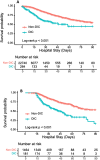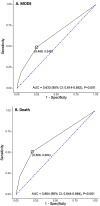Disseminated intravascular coagulation is associated with poor prognosis in patients with COVID-19
- PMID: 38816405
- PMCID: PMC11139854
- DOI: 10.1038/s41598-024-63078-9
Disseminated intravascular coagulation is associated with poor prognosis in patients with COVID-19
Abstract
This study aimed to investigate the incidence and significance of disseminated intravascular coagulation (DIC) in coronavirus disease 2019 (COVID-19). A multicenter cohort study was conducted using large-scale COVID-19 registry data. The patients were classified into DIC and non-DIC groups based on the diagnosis on admission (day 1) and on any of the days 1, 4, 8, and 15. In total, 23,054 patients were divided into DIC (n = 264) and non-DIC (n = 22,790) groups on admission. Thereafter, 1654 patients were divided into 181 patients with DIC and 1473 non-DIC patients based on the DIC diagnosis on any of the days from 1 to 15. DIC incidence was 1.1% on admission, increasing to 10.9% by day 15. DIC diagnosis on admission had moderate predictive performance for developing multiple organ dysfunction syndrome (MODS) on day 4 and in-hospital death and was independently associated with MODS and in-hospital death. DIC diagnosis on any of the days from 1 to 15, especially days 8 and 15, was associated with lower survival probability than those without DIC and showed significant association with in-hospital death. In conclusion, despite its low incidence, DIC, particularly late-onset DIC, plays a significant role in the pathogenesis of poor prognosis in patients with COVID-19.
Keywords: Coronavirus disease 2019 (COVID-19); Disseminated intravascular coagulation (DIC); Incidence; Organ dysfunction; Prognosis.
© 2024. The Author(s).
Conflict of interest statement
The authors declare no competing interest.
Figures




Similar articles
-
Disseminated intravascular coagulation immediately after trauma predicts a poor prognosis in severely injured patients.Sci Rep. 2021 May 26;11(1):11031. doi: 10.1038/s41598-021-90492-0. Sci Rep. 2021. PMID: 34040091 Free PMC article.
-
Soluble thrombomodulin increases in patients with disseminated intravascular coagulation and in those with multiple organ dysfunction syndrome after trauma: role of neutrophil elastase.J Trauma. 1995 Oct;39(4):660-4. doi: 10.1097/00005373-199510000-00007. J Trauma. 1995. PMID: 7473950
-
Tissue factor pathway inhibitor response does not correlate with tissue factor-induced disseminated intravascular coagulation and multiple organ dysfunction syndrome in trauma patients.Crit Care Med. 2001 Feb;29(2):262-6. doi: 10.1097/00003246-200102000-00006. Crit Care Med. 2001. PMID: 11246303
-
Incidence and impact of disseminated intravascular coagulation in COVID-19 a systematic review and meta-analysis.Thromb Res. 2021 May;201:23-29. doi: 10.1016/j.thromres.2021.02.010. Epub 2021 Feb 17. Thromb Res. 2021. PMID: 33631519 Free PMC article.
-
COVID-19-associated coagulopathy and disseminated intravascular coagulation.Int J Hematol. 2021 Jan;113(1):45-57. doi: 10.1007/s12185-020-03029-y. Epub 2020 Nov 7. Int J Hematol. 2021. PMID: 33161508 Free PMC article. Review.
Cited by
-
Efficacy of additional hemoperfusion in hospitalized patients with severe to critical COVID-19 disease.Sci Rep. 2024 Jul 31;14(1):17651. doi: 10.1038/s41598-024-68592-4. Sci Rep. 2024. PMID: 39085334 Free PMC article.
References
Publication types
MeSH terms
Grants and funding
LinkOut - more resources
Full Text Sources
Medical

